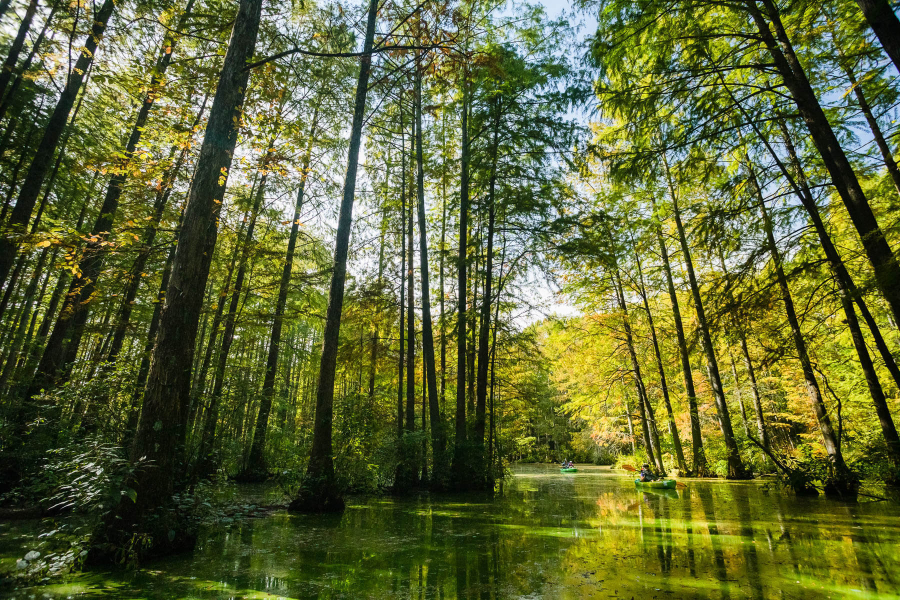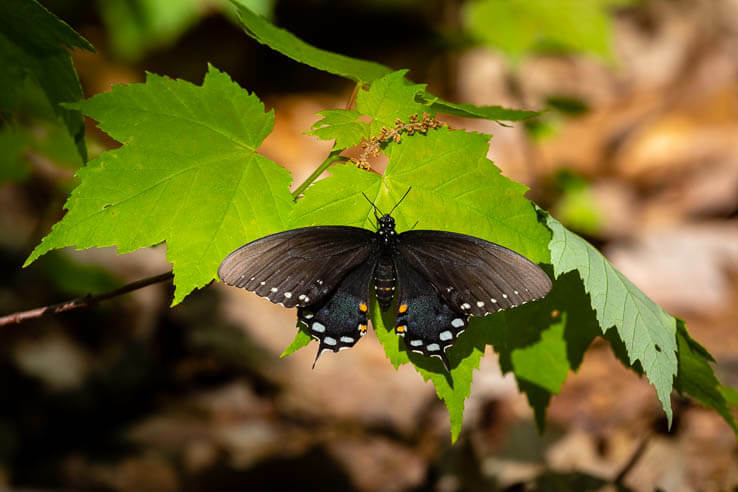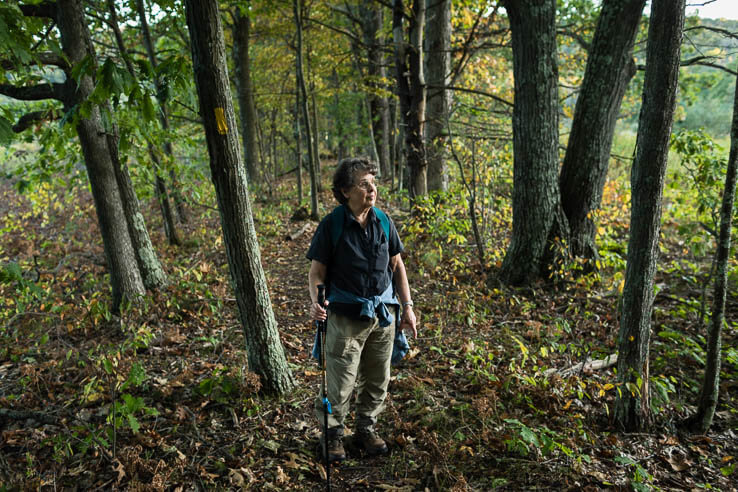Nature Rx
The science behind nature's effect on the human body

For centuries, humans have intuitively understood that getting outside and seeing beautiful vistas is beneficial. Not only do we hike and get out in in nature on our own, but we try and bring it into our indoor spaces. We hang scenic pictures in hotels and hospitals and brighten drab offices with potted plants. During World War II, when everything from butter to typewriters was rationed, the National Park System remained open. Department of the Interior secretary Harold Ickes responded to pressure by stating, “in times of national stress and sorrow, the people need precisely what the National Parks can offer.” We feel better in nature—and it turns out, there’s a physiological reason for it.
Walking through nature means smelling the freshness in the air, watching the birds, hearing the crunch of leaves underfoot, touching the smooth bark of a tree and tasting sun-ripened berries. Your senses get a workout in nature, but your body is also experiencing and reacting below the surface in ways of which you aren’t even aware.
The cellular effect
Multiple studies have shown that being out in nature increases NK cells in the human body. NK cells, or “natural killer” cells, are a type of lymphocyte. They seek out and destroy virally infected cells, particularly those that cause tumors to form in the human body. NK cells do not require activation by another type of cell to attack tumors but rather continuously seek out damaged cells, hence the name.
A Japanese study published in Environmental Health and Preventative Medicine had subjects take three two-hour walks through forested areas over two days. Researchers took blood and urine samples after each walk and compared them to control samples collected before the trip. In each case, NK cell levels and activity increased with the forest walks. Granzyme, perforin and granulysin—proteins delivered by the NK cells to kill tumors and bacteria—also significantly increased.
Researchers replicated the study in an urban setting with the same duration and timing of walks. While subjects enjoyed the same amount of exercise as the forest walks, the same can’t be said for their tumor-fighting cells. Neither NK cell activity and levels nor their helpful proteins significantly changed in value after the urban walks. There was something about the forests that had a biological effect on the human body.
Members of the living world are in constant communication with each other, with battles being waged and alliances forged in silence among plants, insects and fungi. For trees, part of this communication is in the form of phytoncides, chemicals that trees emit into the air to protect themselves from insects and perform other vital functions. Whether by accident or design, humans, as well as plants, insects and fungi, respond to the phytoncides. Researchers have hypothesized that these chemicals cause the increase in NK cells.
Health and nature have traditionally been separate disciplines in the United States, leading researchers to miss this important link to human health and wellness. Craig Highfield, director of the Chesapeake Forests Program with the Alliance for the Chesapeake Bay, was unfamiliar with the studies on phytoncides and human biology but was readily open to the connection given his personal experience in his work: “I’m relaxed when I get out!” enthused Highfield. “That’s why I do what I do. I’m more peaceful just sitting in a tree stand than anywhere else, or just fishing in a wooded stream.”
During a follow-up study, participants stayed in an urban hotel for several nights. Researchers extracted phytoncides from several species of trees and, after taking baseline blood and urine levels for control, piped the phytoncides into the air vents of the rooms. Blood and urine tests were taken again, and as before, NK cell and protein levels increased during and after exposure. What is more, adrenaline and noradrenaline levels in the subjects’ urine—both of which are indicative of stress—decreased with exposure to the phytoncides. Humans experience increased health benefits and decreased stress from spending time in nature.
Healing the mind
Rumination is the tendency to dwell at length on negatives, and it can be a devastating aspect of depression. One might assume that long walks alone would be the perfect storm for harmful rumination, but the opposite was found to be true in a recent study out of Stanford University that was published in the Proceedings in the National Academy of Sciences. When participants took walks in a natural landscape, rumination decreased.
Treatment for a complex affliction like depression requires care for the whole body. Adding to the regimen something as simple as a walk in the park can provide numerous benefits to overall health.
 A spicebush swallowtail butterfly pauses on a leaf at Douthat State Park in Alleghany County, Va., on May 12, 2018. (Photo by Will Parson/Chesapeake Bay Program)
A spicebush swallowtail butterfly pauses on a leaf at Douthat State Park in Alleghany County, Va., on May 12, 2018. (Photo by Will Parson/Chesapeake Bay Program)
There is something about nature that evokes a positive response in the human body, even without exposure to phytoncides. Another study in the Royal Society of Medicine looked at the effect of art on patient recovery after major heart surgery, with three groups being studied: one group with a picture of nature, one with a scene of abstract art, and one with no image at all. Those patients that had an image of nature in their rooms reported lower levels of anxiety and were more likely to switch to less powerful pain medications during their recovery. In another study, patients with a view of trees outside their window healed faster than patients recovering from the same ailment that did not have a view of nature.
The mechanisms of how it functions are still mysterious, and we are only just beginning to scratch the surface of understanding it, but it seems that nature, for humans, heals.
Forest bathing
The Japanese have been embracing the idea of a more connected system—human, animal, plant, neurological, emotional and physical—for decades, and it has yielded the practice of shinrin-yoku. Shinrin-yoku is forest bathing, or the medicine of simply being in a forest. Forest bathing allows you to stop, breathe, sense the world around you and to take in the beauty and life of a forest. Outside of its grounding in science, forest bathing has the added benefit of being available to those at all stages of healing. People can improve their well-being, gain a sense of peace and reduce their stress with a meditative walk. You do not need to be out running the trails—just sitting in nature, breathing in the forest, can promote healing.
 Betsy Darlington hikes through Logan Hill Nature Preserve, comprising nearly 300 acres of forest and meadows in Candor, N.Y., on Oct. 1, 2017. Darlington and her husband Dick donated the property, which they owned since the 1970s, to the Finger Lakes Land Trust in 2015, and it is protected by a conservation easement. (Photo by Will Parson/Chesapeake Bay Program)
Betsy Darlington hikes through Logan Hill Nature Preserve, comprising nearly 300 acres of forest and meadows in Candor, N.Y., on Oct. 1, 2017. Darlington and her husband Dick donated the property, which they owned since the 1970s, to the Finger Lakes Land Trust in 2015, and it is protected by a conservation easement. (Photo by Will Parson/Chesapeake Bay Program)
It is not necessary to understand every way that nature affects the human body to benefit from it. Nature is already incorporated into many healing practices around the world. In the United States, Parks RX prescribes time in parks for healing patients and their families. For Canadians, doctors are prescribing time in art museums to improve patients’ mental peace and to reduce stress. In Scotland, doctors advise patients to get outside into the wilds.
Water and garden therapy
Fishing offers many benefits akin to spending time in forests. Flowing water has some of the same positive psychological effects on the mind, and you doubly benefit when you fish in a forested stream. Across health fields, practitioners are looking to the collective healing benefits of nature, calm and community in fishing to offer enhanced care. In Lancaster, Pennsylvania, Trout Unlimited and Heroes on the Water bring military veterans to the river to fish and kayak. Of all the benefits to the hobby, an Australian survey on recreational fishing found that relaxation and stress relief topped the charts for why people engage.
Hidden gems can be found in unlikely places, and those that don’t have forests nearby or cannot get to them regularly can find some solace in the garden. In Washington, D.C., a community in the heart of the city found peace and each other in a garden that broke up the gray scale of pavement and concrete. The health company Aetna teamed with a neighborhood in Philadelphia, Pennsylvania, to bring about Bartram’s Garden, a place that helped to transform a neighborhood of detached strangers into a community of healing individuals. Kyle J. R. Morris took that understanding of healing to heart in creating Royal by Nature, a life skills group for youth that uses Bartram’s Garden as their classroom. “We taught the kids how to fish. They went boating. They learned to grow their own food and just get their hands dirty,” said Morris. “They made tree houses and learned to put the joysticks down and find the joy that’s in the sticks, literally.”
Handwashing was a revolution for early doctors who scoffed at the notion of bacteria, yet it changed the field of health as we began to acknowledge its presence and incredible impact. When the atom was split, it challenged the widely held scientific notion that the atom was the smallest building block of life. New unseens are discovered constantly. For now, it is a safe bet that whether you want to soothe a troubled mind, heal your body, boost your immune system or just get some exercise, go outside.
To find a place near you to experience the vast array of outdoor options and find some peace in nature, check out Find Your Chesapeake.

Comments
I like the way Caitlyn pulled together so many studies and initiatives that are happening around the world that are focused on the beneficial impact of nature on our health. Right here in Maryland, Nature Worx designs and delivers experiential programs that help people connect with the healing properties of nature. Our partners include substance use treatment facilities, government agencies, corporate wellness programs and nature centers. It's exciting to see the positive impact we are having on people's lives!
Phil Hosmer, Executive Director, Nature Worx, Inc.
What a wonderful article. As a nature center administrator and avid outdoorsman, I can identify. I have seen the benefits of engaging with nature here at Irvine and its positive impact on our visitors and participants from cradle to gray!
Brooks Paternotte
Executive Director, Irvine Nature Center
What an awesome article. I am an Integrative Nutrition Health Coach and I'm always suggesting that my students and clients get out and experience nature to de-stress and get exercise. Your article validates this and give the scientific backing that some people need to act. We are a society that truly needs to get back to basics and your article confirms this. Thanks so much for such a beautiful article.
Caitlyn Johnstone has done a beautiful job of outlining both the scientific research and the plain old common sense that tell us that spending time in nature is good for our mental and physical health. Bravo Caitlyn! Yours is an important contribution to the growing body of literature on the many benefits of spending quiet time in nature!
Melanie Choukas-Bradley, author of The Joy of Forest Bathing and A Year in Rock Creek Park
Thank you!
Your comment has been received. Before it can be published, the comment will be reviewed by our team to ensure it adheres with our rules of engagement.
Back to recent stories